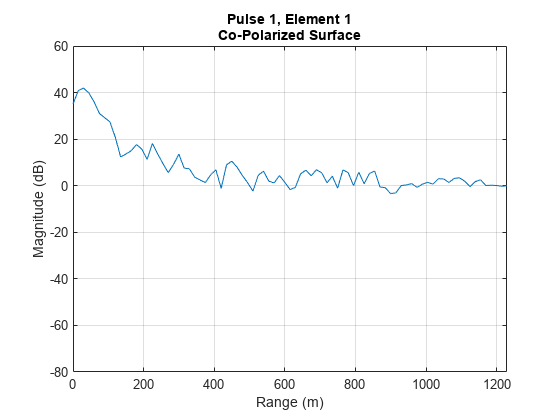updateScatteringMatrix
Description
updateScatteringMatrix(
updates one or more polarization scattering matrices, where surface,Name=Value)surface is
a customSurface object. Name specifies the
property name (Shh, Svv,Shv,
or Svh) and Value updates the corresponding
property value.
Examples
Create Custom Surface
Create a co-polarized custom surface.
% Create a radar scenario rng('default'); scene = radarScenario(IsEarthCentered=false); % Create a co-polarized custom surface bnds = [-600 570; 0 1.17e3]; Shh = zeros(40,40,2); Svv = ones(40,40,2); Shv = zeros(size(Shh)); srf = customSurface(scene,Boundary=bnds, ... CrossPolarization='Symmetric',Shh=Shh,Svv=Svv,Shv=Shv);
Collect I/Q Data
Create a vertically polarized radar I/Q sensor and collect data.
% Create a vertically polarized radar IQ sensor and attach to % a platform freq = 500e6; sweepBW = 5e6; fs = 2*sweepBW; wav = phased.LinearFMWaveform(SampleRate=fs, ... SweepBandwidth=sweepBW); rdr = radarTransceiver(Waveform=wav, ... MountingAngles=[-90 10 0], ... RangeLimits=[0 1.2e3]); element = phased.ShortDipoleAntennaElement; ula = phased.ULA(Element=element); configureAntennas(rdr,Combined=ula); rdr.TransmitAntenna.OperatingFrequency = freq; rdr.ReceiveAntenna.OperatingFrequency = freq; rdr.Receiver.SampleRate = fs; rdrplat = platform(scene,Position=[0 0 10],Sensors=rdr); % Create clutter generator cluttergen = clutterGenerator(scene,rdr,Resolution=30, ... RangeLimit=1.2e3); % Advance scene and collect IQ advance(scene); iq = receive(scene); % Pulse compress mf = getMatchedFilter(rdr.Waveform); rngresp = phased.RangeResponse(SampleRate=fs); [iqPC,rngGrid] = rngresp(iq{1}(:,1),mf); figure nexttile plot(rngGrid,mag2db(abs(iqPC))) title(['Pulse 1, Element 1' newline 'Co-Polarized Surface']) xlabel('Range (m)') ylabel('Magnitude (dB)') grid on axis tight ylim([-80 60])

Update Scattering Matrix Values
Update scattering matrix values for HH and VV components to make the surface cross-polarized and collect I/Q data.
% Update scattering matrix values for HH and VV components. % Make the surface cross-polarized. Shh = ones(40,40,2); Svv = zeros(40,40,2); updateScatteringMatrix(srf,Shh=Shh,Svv=Svv) % Collect IQ iq = receive(scene); [iqPC,rngGrid] = rngresp(iq{1}(:,1),mf); nexttile plot(rngGrid,mag2db(abs(iqPC))) title(['Pulse 2, Element 1' newline ... 'Cross-Polarized Surface']) xlabel('Range (m)') ylabel('Magnitude (dB)') grid on axis tight ylim([-80 60]) sgtitle('Custom Surface')

Input Arguments
Surface, specified as a CustomSurface
object.
Name-Value Arguments
Specify optional pairs of arguments as
Name1=Value1,...,NameN=ValueN, where Name is
the argument name and Value is the corresponding value.
Name-value arguments must appear after other arguments, but the order of the
pairs does not matter.
Example: updateScatteringMatrix(surface,Shh=ones(40,40,2),Svv=zeros(40,40,2))
Specify the complex-valued polarization scattering matrix co-polarized
HH component, where HH represents horizontal
transmission and horizontal reception, as an
M-by-N-by-P matrix.
M indicates the number of components in the
x-direction, N indicates the number of
components in the y-direction, and P corresponds
to the number of elements in the Frequency vector. The matrix is
bounded in space by the Boundary property limits.
Data Types: double
Complex Number Support: Yes
Specify the complex-valued polarization scattering matrix co-polarized
VV component, where VV represents vertical
transmission and vertical reception, as an
M-by-N-by-P matrix.
M indicates the number of components in the
x-direction, N indicates the number of
components in the y-direction, and P corresponds
to the number of elements in the Frequency vector. The matrix is
bounded in space by the Boundary property limits.
Data Types: double
Complex Number Support: Yes
Specify the complex-valued polarization scattering matrix cross-polarized
HV component, where HV represents horizontal
transmission and vertical reception, as an
M-by-N-by-P matrix.
M indicates the number of components in the
x-direction, N indicates the number of
components in the y-direction, and P corresponds
to the number of elements in the Frequency vector. The matrix is
bounded in space by the Boundary property limits.
Data Types: double
Complex Number Support: Yes
Specify the complex-valued polarization scattering matrix cross-polarized
VH component, where VH represents vertical
transmission and horizontal reception, as an
M-by-N-by-P matrix.
M indicates the number of components in the
x-direction, N indicates the number of
components in the y-direction, and P corresponds
to the number of frequencies in Frequency. The matrix is bounded in
space by the Boundary property limits.
Dependencies
To enable this property, set the CrossPolarization property
to "full".
Data Types: double
Complex Number Support: Yes
Version History
Introduced in R2024a
See Also
CustomSurface | customSurface | SurfaceManager | radarScenario
MATLAB Command
You clicked a link that corresponds to this MATLAB command:
Run the command by entering it in the MATLAB Command Window. Web browsers do not support MATLAB commands.
选择网站
选择网站以获取翻译的可用内容,以及查看当地活动和优惠。根据您的位置,我们建议您选择:。
您也可以从以下列表中选择网站:
如何获得最佳网站性能
选择中国网站(中文或英文)以获得最佳网站性能。其他 MathWorks 国家/地区网站并未针对您所在位置的访问进行优化。
美洲
- América Latina (Español)
- Canada (English)
- United States (English)
欧洲
- Belgium (English)
- Denmark (English)
- Deutschland (Deutsch)
- España (Español)
- Finland (English)
- France (Français)
- Ireland (English)
- Italia (Italiano)
- Luxembourg (English)
- Netherlands (English)
- Norway (English)
- Österreich (Deutsch)
- Portugal (English)
- Sweden (English)
- Switzerland
- United Kingdom (English)